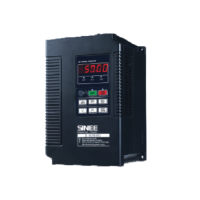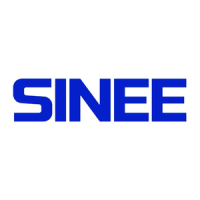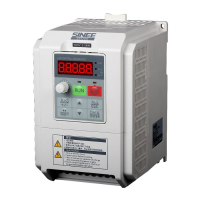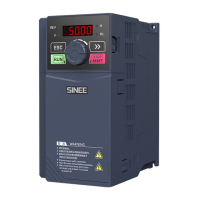Do you have a question about the Sinee EM303A-1R5G/2R2P-3CB and is the answer not in the manual?
Instructions and warnings for safe operation and installation.
Critical safety warnings and precautions for electrical wiring.
Diagram showing peripheral connections to the EM303A inverter.
Warnings and guidelines for performing initial trial operations.
Step-by-step guide for performing trial operation.
General safety advice for handling and modifying the inverter.
Details on models EM303A-XXX-1C and EM303A-XXX-2C specifications.
Comprehensive list of EM303A models and their technical specs.
Explains V/F, SVC0 (Open-loop vector), SVC1 (Torque control) modes.
Checklist for verifying the EM303A inverter upon delivery.
Guidelines for selecting a suitable installation location and ambient temperature.
Illustrations of main circuit terminal blocks for different models.
Explains the purpose of each main circuit terminal.
Recommendations for installing circuit breakers, contactors, and reactors.
Instructions for connecting inverter output terminals to the motor.
Warnings against connecting power to outputs, shorting, capacitors, and switches.
Table detailing cable sizes, screw types, and torques for main circuits.
Proper grounding procedures and precautions for the inverter.
Lists analog, numeric, and communication terminals.
Wiring diagrams for analog voltage and current inputs.
Wiring configurations for multi-function numeric input terminals.
Diagrams for connecting to PC or PLC via RS485.
Post-wiring checks to ensure correct installation and security.
Identifies keypad components and their functions.
Details the six main keypad operation modes and their functions.
Explains control modes, parameters, and trial operation checks.
Essential checks before powering off during trial operation.
Detailed description of motor-related parameters (F1 group).
Parameters for motor type, power, voltage, current, speed, wiring, PF, efficiency.
Parameters like R1, R2, Ls, Lm, I0 used for motor autotuning.
Detailed description of parameters for input/output terminals (F2 group).
Detailed description of preset speed operation parameters (F3 group).
Detailed description of general vector control parameters (F5 group).
Detailed description of fault codes and related parameters (E0 group).
Parameters for controlling program operation (PLC) sequences (F6 group).
Detailed description of advanced vector control parameters (FA group).
Detailed description of advanced PID parameters (Fb group).
Detailed explanations for General Parameters (F0 group).
Detailed description of general PID parameters (F4 group).
Adjusting the PID output gain for performance.
Details on Proportion Gain (GP), Integration Time (GTi), Differentiation Time (GTd).
Explanation of how torque control works in SVC1 mode.
Parameters related to torque current acceleration and deceleration times.
Setting limits for power and brake torque current.
Explanation of the autotuning function for vector control.
Safety and operational precautions before performing autotuning.
Step-by-step guide for performing motor autotuning.
Correctly setting motor parameters from the nameplate before autotuning.
Table of trip codes, causes, and corrective actions for faults.
Detailed explanations for various fault causes and solutions.
How the fault retry function operates after a fault occurs.
Troubleshooting issues related to parameter settings not saving or editing.
Analysis of abnormal motor operations like not running or reversing.
Troubleshooting causes for excessively long acceleration times.
Troubleshooting causes for excessively long deceleration times.
Causes and solutions for inverter overheating issues.
Troubleshooting when the leakage current circuit breaker is triggered.
Reasons why the inverter might stop output while the motor is still running.
Troubleshooting when output frequency deviates from the set value.
Required daily checks and regular maintenance procedures.
Specific checks to perform while the inverter is operating.
Periodic checks to ensure sustained performance.
Standards for replacing internal parts based on service life.
Instructions and warnings for safe operation and installation.
Critical safety warnings and precautions for electrical wiring.
Diagram showing peripheral connections to the EM303A inverter.
Warnings and guidelines for performing initial trial operations.
Step-by-step guide for performing trial operation.
General safety advice for handling and modifying the inverter.
Details on models EM303A-XXX-1C and EM303A-XXX-2C specifications.
Comprehensive list of EM303A models and their technical specs.
Explains V/F, SVC0 (Open-loop vector), SVC1 (Torque control) modes.
Checklist for verifying the EM303A inverter upon delivery.
Guidelines for selecting a suitable installation location and ambient temperature.
Illustrations of main circuit terminal blocks for different models.
Explains the purpose of each main circuit terminal.
Recommendations for installing circuit breakers, contactors, and reactors.
Instructions for connecting inverter output terminals to the motor.
Warnings against connecting power to outputs, shorting, capacitors, and switches.
Table detailing cable sizes, screw types, and torques for main circuits.
Proper grounding procedures and precautions for the inverter.
Lists analog, numeric, and communication terminals.
Wiring diagrams for analog voltage and current inputs.
Wiring configurations for multi-function numeric input terminals.
Diagrams for connecting to PC or PLC via RS485.
Post-wiring checks to ensure correct installation and security.
Identifies keypad components and their functions.
Details the six main keypad operation modes and their functions.
Explains control modes, parameters, and trial operation checks.
Essential checks before powering off during trial operation.
Detailed description of motor-related parameters (F1 group).
Parameters for motor type, power, voltage, current, speed, wiring, PF, efficiency.
Parameters like R1, R2, Ls, Lm, I0 used for motor autotuning.
Detailed description of parameters for input/output terminals (F2 group).
Detailed description of preset speed operation parameters (F3 group).
Detailed description of general vector control parameters (F5 group).
Detailed description of fault codes and related parameters (E0 group).
Parameters for controlling program operation (PLC) sequences (F6 group).
Detailed description of advanced vector control parameters (FA group).
Detailed description of advanced PID parameters (Fb group).
Detailed explanations for General Parameters (F0 group).
Detailed description of general PID parameters (F4 group).
Adjusting the PID output gain for performance.
Details on Proportion Gain (GP), Integration Time (GTi), Differentiation Time (GTd).
Explanation of how torque control works in SVC1 mode.
Parameters related to torque current acceleration and deceleration times.
Setting limits for power and brake torque current.
Explanation of the autotuning function for vector control.
Safety and operational precautions before performing autotuning.
Step-by-step guide for performing motor autotuning.
Correctly setting motor parameters from the nameplate before autotuning.
Table of trip codes, causes, and corrective actions for faults.
Detailed explanations for various fault causes and solutions.
How the fault retry function operates after a fault occurs.
Troubleshooting issues related to parameter settings not saving or editing.
Analysis of abnormal motor operations like not running or reversing.
Troubleshooting causes for excessively long acceleration times.
Troubleshooting causes for excessively long deceleration times.
Causes and solutions for inverter overheating issues.
Troubleshooting when the leakage current circuit breaker is triggered.
Reasons why the inverter might stop output while the motor is still running.
Troubleshooting when output frequency deviates from the set value.
Required daily checks and regular maintenance procedures.
Specific checks to perform while the inverter is operating.
Periodic checks to ensure sustained performance.
Standards for replacing internal parts based on service life.












